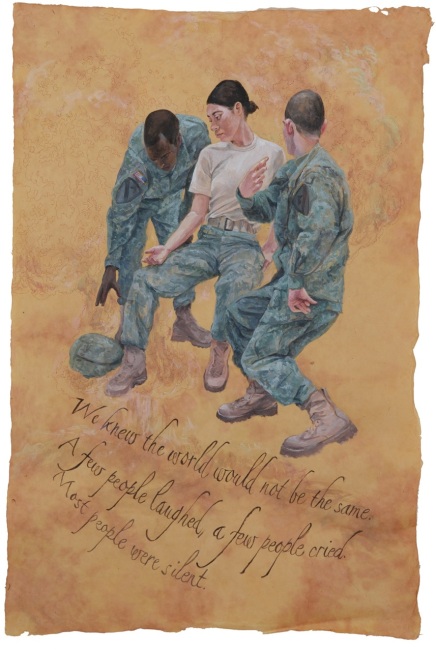The Last Judgment, Prophet 9
By Tatiana Garmendia
In 2010 I began a series of portraits in which veterans from the wars in Iraq and Afghanistan assumed poses directly taken from Michelangelo’s Sistine Chapel masterpiece, The Last Judgment. They posed as savior, martyr, saint, damned and demon — and I painted them. Usually they wore camo, sometimes they wore battle gear. I titled these pieces The Prophets. Each painting portrays one or more soldiers in front of a contour line landscape that has become a pattern akin to camo. Only the fracturing is caused by an explosion.
Each soldier takes on the role of prophet not by quoting from a holy book, but from a well-known Hollywood movie or televised image. The mythologizing function of war movies and televised images reveal a kind of Eternal Return, as the sacred intrudes upon our world with its archetypes and heroes. These are narrative arcs that often define our complex attitudes towards war.
In The Last Judgment, Prophet 9, three US Army soldiers gesture in response to Robert Oppenheimer’s famous edict in the 1965 televised documentary, The Decision to Drop the Bomb. Oppenheimer speaks about his response to the atomic bombings of Hiroshima and Nagasaki, and then goes on to quote from the Bhagavad Gita: http://www.youtube.com/watch?v=n8H7Jibx-c0
Oppenheimer never makes eye contact with the viewer or the camera during his rationalization of the use of nuclear weapons in civilian centers. Although he was a scientist, not the head of the armed forces who made the decision to do just that, it is very clear Oppenheimer feels a deep sense of responsibility for the suffering and destruction caused by his work on nuclear fusion. He even quotes Shiva, “I am become Death, the destroyer of worlds.”
In Prophet 9, each soldier gestures in front of a contour line drawing of a mushroom cloud. One reaches for his helmet which has dropped to the ground. Another looks down in apparent dejection, while the third turns towards the explosion and points in our direction, perhaps implicating us in some way. Did we give the orders that detonated the explosion he looks at?
Three veterans posed for this piece– one black, one brown, one white– and they were all US Army. Despite different ethnic and racial backgrounds, each wore the same uniform, became part of the same family united in a common military action. Each suffered severe trauma as a result of their experience of war, which included the terrifying and soul destroying decision to kill or be killed.
A profound connection occurs between an artist and her models. As I painted Prophet 9, I saw myself in them. Perhaps because war and political conflicts caused so much suffering in my immediate family. Perhaps because under my skin, run brown, black, and white ethnic and racial blood lines.
And as I painted Oppenheimer’s quote, the prophesy in this piece, I also felt a deep sense of complicity. Perhaps because I live in and love a country that is at war, and war always causes death and destruction. Perhaps because these young heroes became destroyers of worlds to defend the freedoms and privileges that I get to enjoy at no mortal cost. Maybe, because like Oppenheimer said, I am like most people, and too often remain silent.
About the Author: Tatiana Garmendia is a Cuban-born artist living and teaching in Seattle. She exhibits widely and is in public collections in the US and abroad. Her work is figurative and driven by existential questions that probe history and culture.
